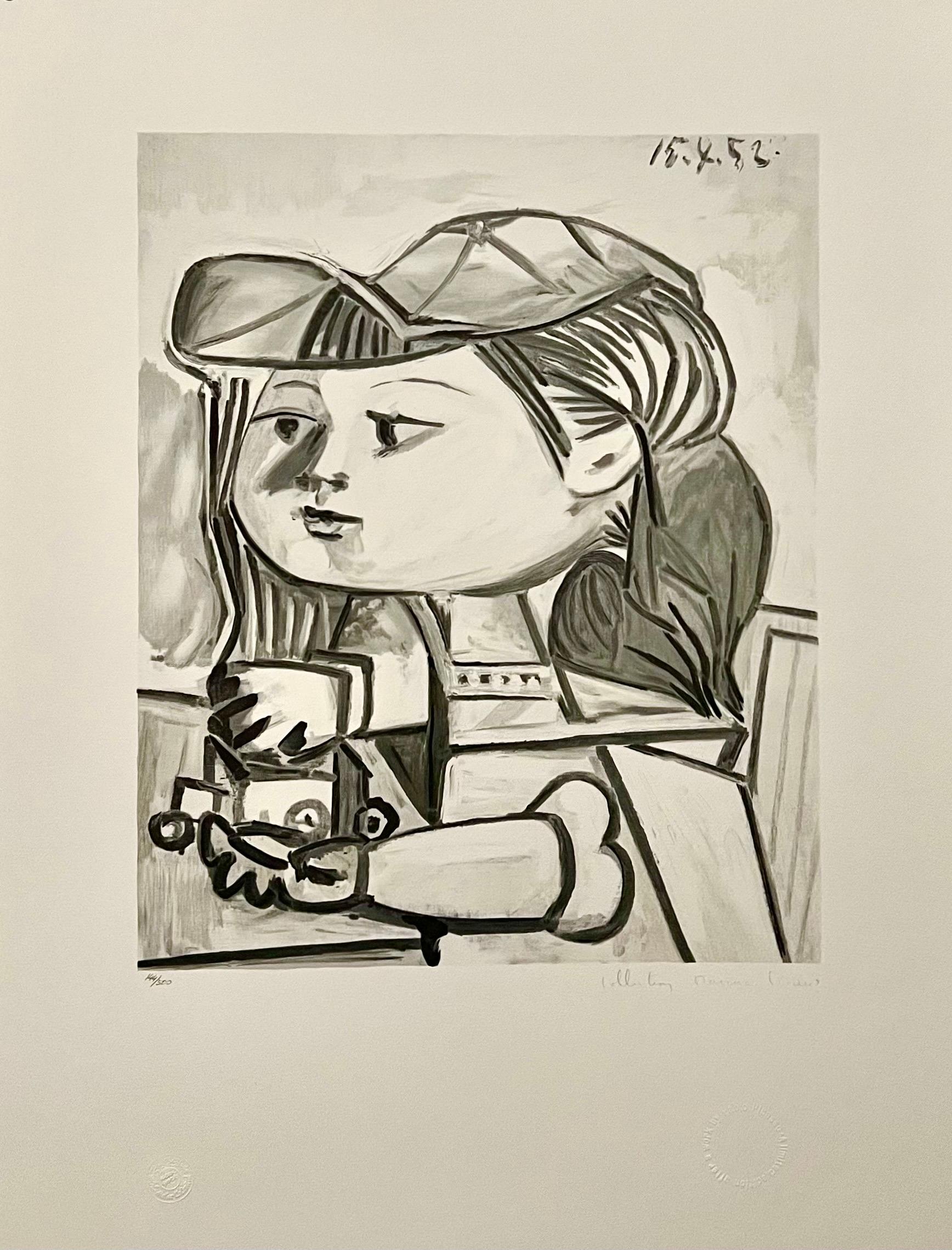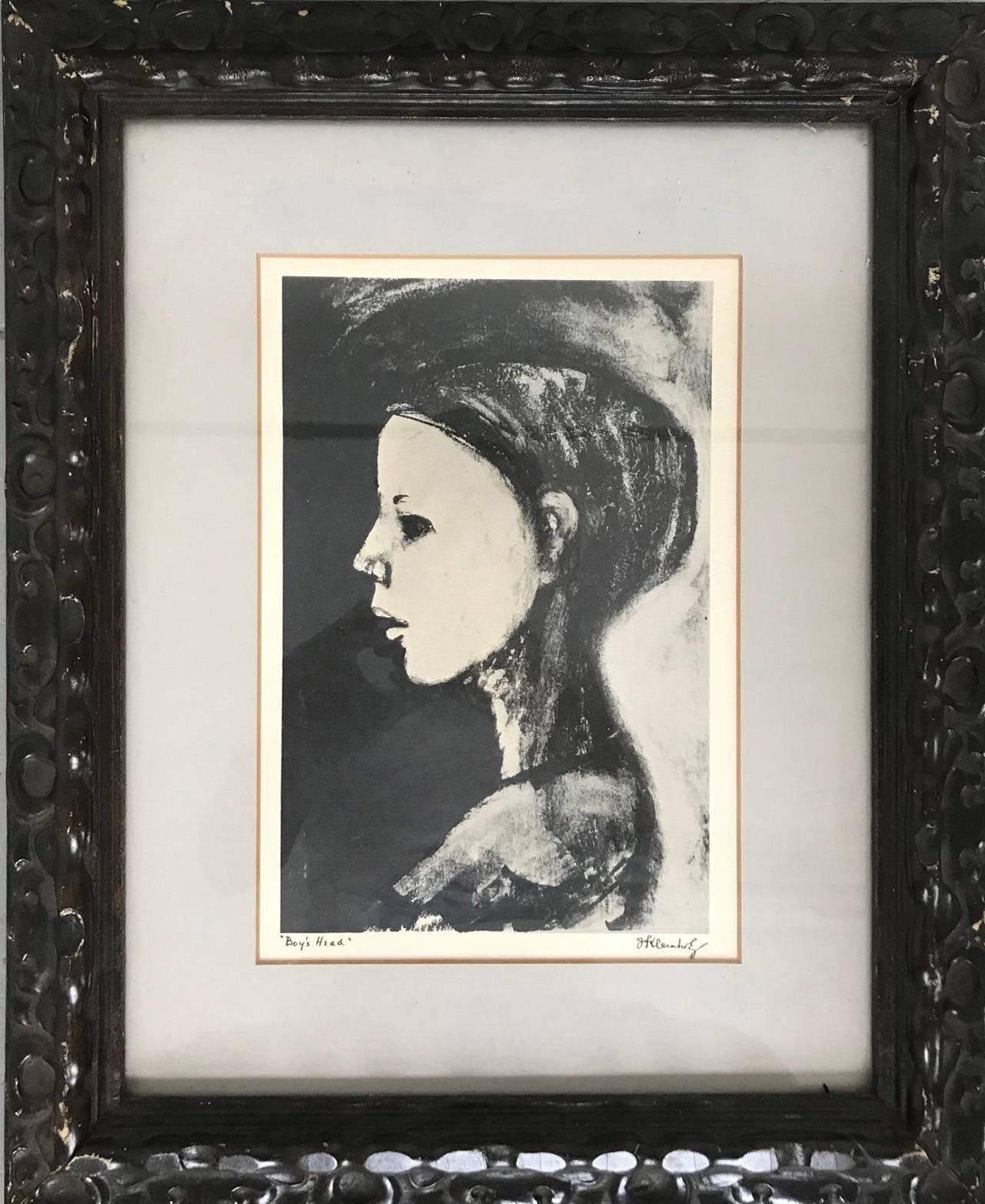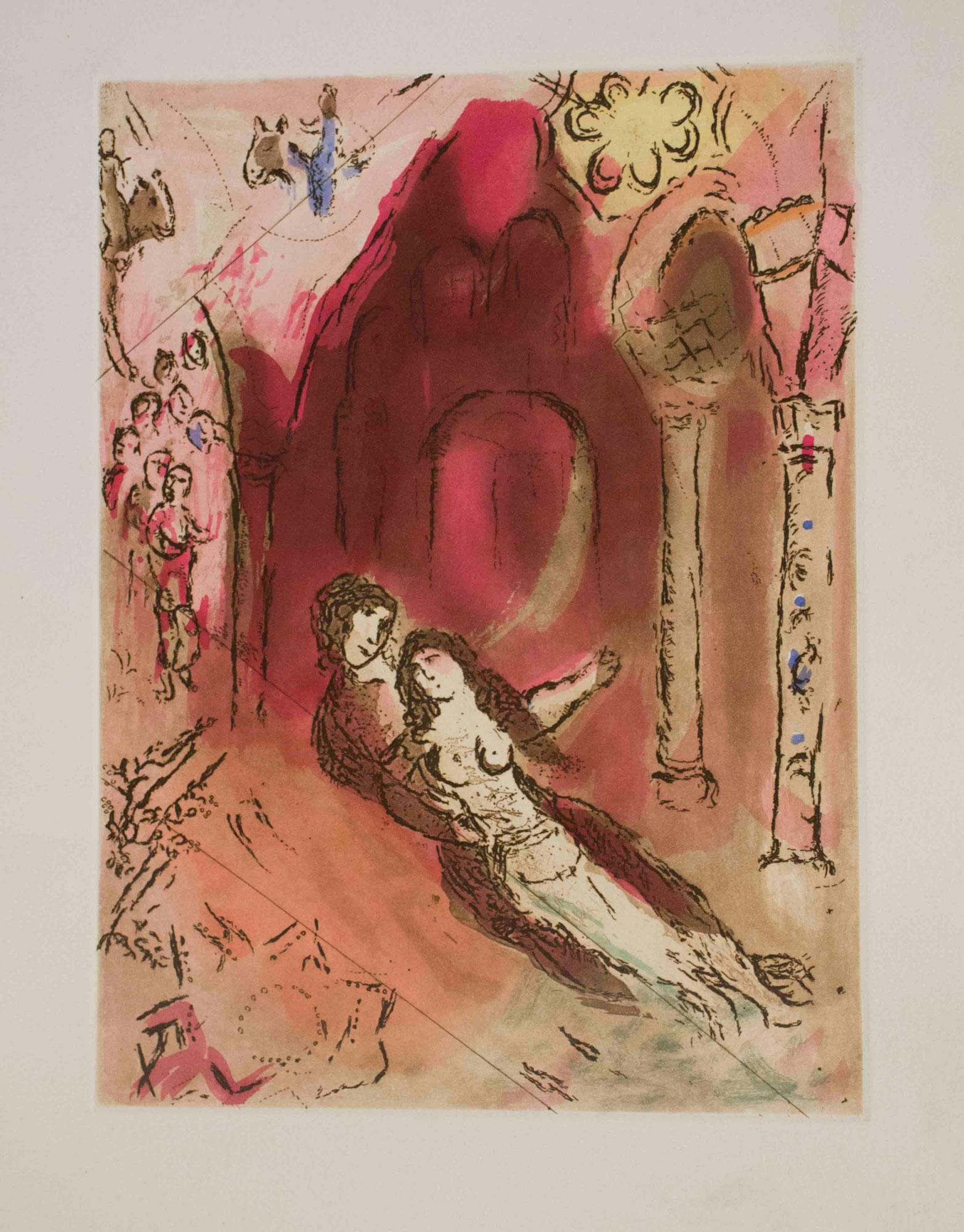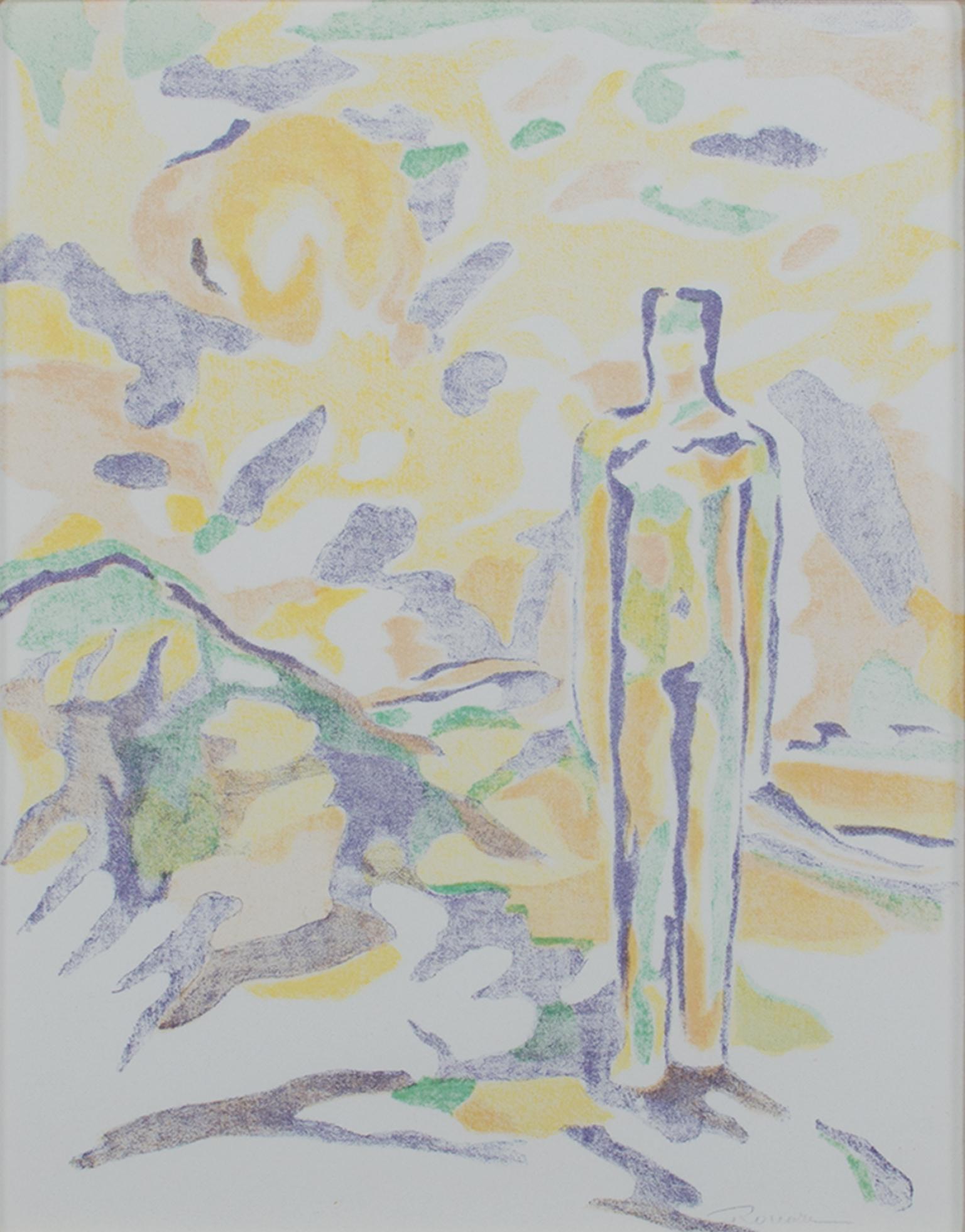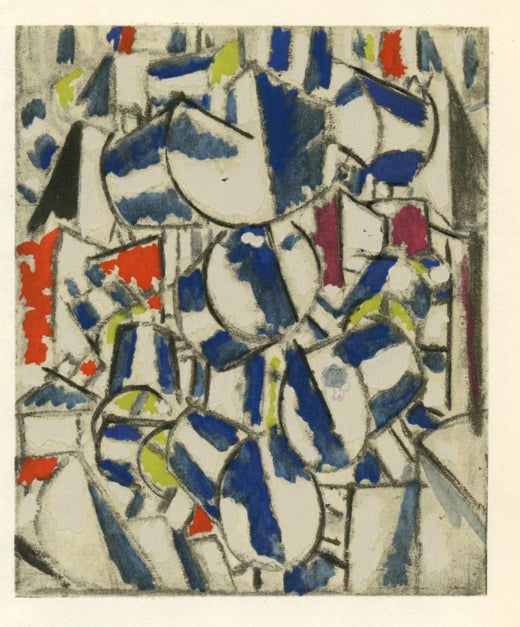Items Similar to Fernand Leger School Prints Colorful Modernist King of Hearts Drawing Lithograph
Want more images or videos?
Request additional images or videos from the seller
1 of 10
(after) Fernand LégerFernand Leger School Prints Colorful Modernist King of Hearts Drawing Lithographc.1949
c.1949
About the Item
Bright vibrant blue, orange, red, yellow, green lithograph in color. This is signed in the plate and dated. Leger's abstract drawing lithograph was drawn by the artist direct on to plastic plates newly developed by Cowell's of Ipswich, and proofed under his supervision. The original edition called for 3000. I do not know how many were actually printed.
The sheer logistics of the operation, the costly effort of distribution to over 4000 schools, finally ended the great adventure of the School Prints scheme. The expensive endeavor peaked in 1949 with the magnificent European series, made possible by the plastic portable plates, which, in addition to Moore, featured Henri Matisse, Pablo Picasso, Fernand Leger, Raoul Dufy and Georges Braque.
Joseph Fernand Henri Léger (French 1881 – 1955) was a French painter, sculptor, and filmmaker. In his early works he created a personal form of cubism which he gradually modified into a more figurative, populist style. His boldly simplified treatment of modern subject matter has caused him to be regarded as a forerunner of pop art.
Léger was born in Argentan, Orne, Lower Normandy, where his father raised cattle. Fernand Léger initially trained as an architect from 1897 to 1899, before moving in 1900 to Paris, where he supported himself as an architectural draftsman. After military service in Versailles, Yvelines, in 1902–1903, he enrolled at the School of Decorative Arts after his application to the École des Beaux-Arts was rejected. He nevertheless attended the Beaux-Arts as a non-enrolled student, spending what he described as "three empty and useless years" studying with Gérôme and others, while also studying at the Académie Julian. He began to work seriously as a painter only at the age of 25. At this point his work showed the influence of impressionism, as seen in Le Jardin de ma mère (My Mother's Garden) of 1905, one of the few paintings from this period that he did not later destroy. A new emphasis on drawing and geometry appeared in Léger's work after he saw the Cézanne retrospective at the Salon d'Automne in 1907.
In 1909 he moved to Montparnasse and met Alexander Archipenko, Jacques Lipchitz, Marc Chagall, Joseph Csaky and Robert Delaunay. In 1910 he exhibited at the Salon d'Automne in the same room (salle VIII) as Jean Metzinger and Henri Le Fauconnier. In his major painting of this period, Nudes in the Forest, Léger displays a personal form of Cubism that his critics termed "Tubism" for its emphasis on cylindrical forms.
In 1911 the hanging committee of the Salon des Indépendants placed together the painters identified as 'Cubists'. Metzinger, Albert Gleizes, Le Fauconnier, Delaunay and Léger were responsible for revealing Cubism to the general public for the first time as an organized group.
The following year he again exhibited at the Salon d'Automne and Indépendants with the Cubists, and joined with several artists, including Le Fauconnier, Metzinger, Gleizes, Francis Picabia and the Duchamp brothers, Jacques Villon, Raymond Duchamp-Villon and Marcel Duchamp to form the Puteaux Group—also called the Section d'Or (The Golden Section).
Léger's paintings, from then until 1914, became increasingly abstract. Their tubular, conical, and cubed forms are laconically rendered in rough patches of primary colors plus green, black and white, as seen in the series of paintings with the title Contrasting Forms. Léger made no use of the collage technique pioneered by Georges Braque and Pablo Picasso.As an enthusiast of the modern, Léger was greatly attracted to cinema, and for a time he considered giving up painting for filmmaking. In 1924, in collaboration with Dudley Murphy, George Antheil, and Man Ray, Léger produced and directed the iconic and Futurism-influenced film Ballet Mécanique (Mechanical Ballet). Neither abstract nor narrative, it is a series of images of a woman's lips and teeth, close-up shots of ordinary objects, and repeated images of human activities and machines in rhythmic movement. In collaboration with Amédée Ozenfant he established a free school where he taught from 1924, with Alexandra Exter and Marie Laurencin. He produced the first of his "mural paintings", influenced by Le Corbusier's theories.
His varied projects included book illustrations, murals, stained-glass windows, mosaics, polychrome ceramic sculptures, and set and costume designs.
He was active as a teacher for many years, first at the Académie Vassilieff in Paris, then in 1931 at the Sorbonne, and then developing his own Académie Fernand Léger, which was in Paris, then at the Yale School of Art and Architecture (1938–1939), Mills College Art Gallery in Oakland, California during 1940–1945, before he returned to France. Among his many pupils were Hananiah Harari, Asger Jorn, Michael Loew, Beverly Pepper, Marcel Mouly, Louise Bourgeois, Tsuguharu Foujita, Sam Francis, Serge Gainsbourg, Hans Hartung, Florence Henri, Asger Jorn, William Klein, Maryan, Jules Olitski, Erik Olson, and Richard Stankiewicz.
In 1952, a pair of Léger murals was installed in the General Assembly Hall of the United Nations headquarters in New York City. In 1960, the Musée Fernand Légerwas opened in Biot, Alpes-Maritimes, France. In May 2008, his painting Étude pour la femme en bleu (1912–13) sold for $39,241,000 (hammer price with buyer's premium) United States dollars.
- Creator:(after) Fernand Léger (1881 - 1955, French)
- Creation Year:c.1949
- Dimensions:Height: 25.25 in (64.14 cm)Width: 35.5 in (90.17 cm)
- Medium:
- Movement & Style:
- Period:
- Condition:the piece is mounted to another paper for support, as issued. minor wear. the lithograph is in good condition with minor age toning commensurate with age. please see photos.
- Gallery Location:Surfside, FL
- Reference Number:1stDibs: LU38214212522
(after) Fernand Léger
This print is part of my private collection. They were published in a numbered unsigned edition of 1000, and a signed edition of 200, printed by Serifraphie Fernand Leger, Paris and published by La Guilde International de la Gravure, Jean Bruller 1954/55. Initials in plate. They are catalogued in Lawrence Saphire's "Fernand Leger- Complete Graphic Work." They come from a portfolio sute of 10 serigraphs after original Fernand Leger gouaches. Fernand Leger 1881-1955, French was one of the major Cubist painters in France, later he also became a sculptor, art educator and filmmaker. In the early 1900's he was influenced by Cezanne and began creating in a more geometric style. He created his own style called Tubism with emphasis in cylindrical forms. He was considered one of France's three major Cubist painters among Picasso and Georges Brayer. Leger was influenced by the Italian "Futurism" style.
About the Seller
4.9
Platinum Seller
These expertly vetted sellers are 1stDibs' most experienced sellers and are rated highest by our customers.
Established in 1995
1stDibs seller since 2014
1,559 sales on 1stDibs
Typical response time: 1 hour
- ShippingRetrieving quote...Ships From: Surfside, FL
- Return PolicyA return for this item may be initiated within 3 days of delivery.
More From This SellerView All
- Pablo Picasso Estate Hand Signed Cubist Lithograph Abstract Girl Portrait TeteBy (after) Pablo PicassoLocated in Surfside, FLPablo Picasso (after) "Buste de Petite Fille" limited edition print on Arches paper, Hand signed by Marina Picasso lower right and numbered 144/500 lower left From the estate of Pa...Category
20th Century Modern Abstract Prints
MaterialsLithograph
- Raoul Dufy School Prints Colorful Modernist Drawing Lithograph Marching BandBy (after) Raoul DufyLocated in Surfside, FLBright vibrant blue, yellow lithograph in color. This is signed in the plate and dated. Dufy's abstract drawing lithograph was drawn by the artist direct on to plastic plates newly d...Category
1940s Modern Abstract Prints
MaterialsLithograph
- Large Venezuelan Modernist Lithograph "The Balcony #3" Color PrintBy Marius SznajdermanLocated in Surfside, FLMarius Sznajderman was a painter, printmaker and scenic designer living and working in the United States. Born in Paris, France in 1926 his Jewish parents had migrated to France from Poland in 1923. In November 1942 the family fled Nazi-occupied France for Spain before settling in Caracas, Venezuela. He attended the School of Fine Arts in Caracas where his teachers included illustrator Ramon Martin Durban, scenic designer Charles Ventrillon-Horber and painter Rafael Monasterios. and immigrated to the United States in 1949, where he received a Bachelor of Fine Arts and Master of Fine Arts from Columbia University in New York. He settled in Hackensack, New Jersey, where he lived and had a studio for more than 50 years before moving to Amherst, Massachusetts in 2015. His work, which includes painting, prints and collages, as well as set designs, is in more than 45 museum and public institution collections in the United States, Latin America and Israel. He held more than 40 solo exhibitions at galleries and museums and participated in more than 75 group shows around the globe. He helped found the Taller Libre de Arte, an experimental workshop for the visual arts, sponsored by the Ministry of Education. The Taller Libre de Arte was a center for young artists to work and to meet with critics and intellectuals to discuss avant-garde ideas and artistic trends from Europe and Latin America. Among the notable artists who participated in the Taller Libre de Arte were Ramón Vásquez Brito, Carlos González Bogen, Luis Guevara Moreno, Mateo Manaure, Virgilio Trómpiz...Category
20th Century Modern Figurative Prints
MaterialsLithograph
- Pablo Picasso Estate Hand Signed Lithograph Engraving Fauvist Dove of PeaceBy (after) Pablo PicassoLocated in Surfside, FLPablo Picasso (after) "Etudes des Mains et Colombe" limited edition print on Arches paper, Hand signed by Marina Picasso lower right and numbered 482/500 lower left From the estate of Pablo Picasso with an embossed blindstamp in the lower right side of the piece. After Pablo Picasso's death in 1973, his granddaughter Marina authorized the printing of these original lithographs, which have come to be known as the Picasso Estate...Category
20th Century Modern Abstract Prints
MaterialsLithograph, Engraving
- Pablo Picasso Estate Hand Signed Cubist Lithograph Abstract Woman Portrait TeteBy (after) Pablo PicassoLocated in Surfside, FLPablo Picasso (after) "Femme Assise dans un Fauteuil" limited edition print on Arches paper, Hand signed by Marina Picasso lower right and numbered 284/500 lower left From the estat...Category
20th Century Modern Abstract Prints
MaterialsLithograph
- Henry Moore 1973 Lithograph edition 28/75 Sculpture Figures Reclining NudesBy Henry MooreLocated in Surfside, FLHenry Spencer Moore (1898 – 1986) Moore was born in Castleford, the son of a coal miner. He became well-known through his carved marble and larger-scale abstract cast bronze sculptures, and was instrumental in introducing a particular form of modernism to the United Kingdom later endowing the Henry Moore Foundation, which continues to support education and promotion of the arts. After the Great War, Moore received an ex-serviceman's grant to continue his education and in 1919 he became a student at the Leeds School of Art (now Leeds College of Art), which set up a sculpture studio especially for him. At the college, he met Barbara Hepworth, a fellow student who would also become a well-known British sculptor, and began a friendship and gentle professional rivalry that lasted for many years. In Leeds, Moore also had access to the modernist works in the collection of Sir Michael Sadler, the University Vice-Chancellor, which had a pronounced effect on his development. In 1921, Moore won a scholarship to study at the Royal College of Art in London, along with Hepworth and other Yorkshire contemporaries. While in London, Moore extended his knowledge of primitive art and sculpture, studying the ethnographic collections at the Victoria and Albert Museum and the British Museum. Moore's familiarity with primitivism and the influence of sculptors such as Constantin Brâncuși, Jacob Epstein, Henri Gaudier-Brzeska and Frank Dobson led him to the method of direct carving, in which imperfections in the material and marks left by tools became part of the finished sculpture. After Moore married, the couple moved to a studio in Hampstead at 11a Parkhill Road NW3, joining a small colony of avant-garde artists who were taking root there. Shortly afterward, Hepworth and her second husband Ben Nicholson moved into a studio around the corner from Moore, while Naum Gabo, Roland Penrose, Cecil Stephenson and the art critic Herbert Read also lived in the area (Read referred to the area as "a nest of gentle artists"). This led to a rapid cross-fertilization of ideas that Read would publicise, helping to raise Moore's public profile. The area was also a stopping-off point for many refugee artists, architects and designers from continental Europe en route to America—some of whom would later commission works from Moore. In 1932, after six year's teaching at the Royal College, Moore took up a post as the Head of the Department of Sculpture at the Chelsea School of Art. Artistically, Moore, Hepworth and other members of The Seven and Five Society would develop steadily more abstract work, partly influenced by their frequent trips to Paris and their contact with leading progressive artists, notably Pablo Picasso, Georges Braque, Jean Arp and Alberto Giacometti. Moore flirted with Surrealism, joining Paul Nash's modern art movement "Unit One", in 1933. In 1934, Moore visited Spain; he visited the cave of Altamira (which he described as the "Royal Academy of Cave Painting"), Madrid, Toledo and Pamplona. Moore made his first visit to America when a retrospective exhibition of his work opened at the Museum of Modern Art in New York City.[28] Before the war, Moore had been approached by educator Henry Morris, who was trying to reform education with his concept of the Village College. Morris had engaged Walter Gropius as the architect for his second village college at Impington near Cambridge, and he wanted Moore to design a major public sculpture for the site. In the 1950s, Moore began to receive increasingly significant commissions. He exhibited Reclining Figure: Festival at the Festival of Britain in 1951, and in 1958 produced a large marble reclining figure for the UNESCO building in Paris. With many more public works of art, the scale of Moore's sculptures grew significantly and he started to employ an increasing number of assistants to work with him at Much Hadham, including Anthony Caro and Richard Wentworth. Moore produced at least three significant examples of architectural sculpture during his career. In 1928, despite his own self-described extreme reservations, he accepted his first public commission for West Wind for the London Underground Building at 55 Broadway in London, joining the company of Jacob Epstein and Eric Gill..At an introductory speech in New York City for an exhibition of one of the finest modernist sculptors, Alberto Giacometti, Sartre spoke of The beginning and the end of history...Category
1970s Modern Abstract Prints
MaterialsLithograph
You May Also Like
- Boy's HeadBy Frank KleinholzLocated in New York, NYFrank Kleinholz (American 1901-1987) " Boy's Head", Abstract/ Modernist Lithograph, 10 x 6.75, Mid to Late 20th Century Colors: Black and White *In Frame Measurement: 13.75 x 10.50...Category
Late 20th Century Modern Abstract Prints
MaterialsLithograph
- GranadaBy (after) Marc ChagallLocated in Mount Vernon, NYDate: 1962 Etching with Aquatint (Restrike) Image Size: 13 x 9 inchesCategory
1980s Modern Abstract Prints
MaterialsLithograph
- POISEBy Robert RauschenbergLocated in Aventura, FLOffset lithograph in colors. Hand signed, dated and numbered by the artist. Artwork is in excellent condition. Certificate of authenticity included. Edition of 48. All reasonable off...Category
1990s Modern Abstract Prints
MaterialsPaper, Lithograph, Offset
- Pour Daniel-Henry Kahnweiler Figure in LandscapeBy Yves RouvreLocated in Milwaukee, WI"Pour Daniel-Henry Kahnweiler Figure in Landscape" is an original lithograph by Yves Rouvre. The artist signed the piece lower right. It features an abstracted figure in fields of co...Category
1960s Modern Figurative Prints
MaterialsLithograph
- Two Faces, Modern Self-Portrait Lithograph of the Artist Aging in Pink & GreenBy Dennis John AshbaughLocated in Soquel, CALimited edition hand signed lithograph featuring two consecutive modern portraits of faces with varying degrees of abstraction, in pink and green, by Dennis john Ashbaugh (American, b. 1946). Numbered "7/7" in the lower-left corner. Signed "Dennis John Ashbaugh" in the lower right corner. Presented in a new tan mat with foam core backing. Unframe. Image size: 4"H x 6.75"W. Some toning yellowing at mat opening. Dennis John Ashbaugh (American, b. 1946) was born in Red Oak, Iowa, and attended California State University at Fullerton, receiving his MA in 1969. Ashbaugh has spent most of his career in New York City. In 1992, he collaborated with William Gibson, a fiction writer, and with publisher Kevin Begos on a book, Agrippa, meaning 'book of the dead'. Exhibition venues include the Metropolitan Museum of Art in New York City, the P.S.1 Contemporary Art Center, the Seattle Art Museum, and the Whitney Museum of American ArtPublic collections holding his work include the Hirshhorn Museum, the Museum of Fine Arts, Houston, the Los Angeles County Museum of Art, and the New York Metropolitan. He received a Guggenheim Fellowship. Ashbaugh lives in a trim frame house in Flamingo Park...Category
1970s Modern Figurative Prints
MaterialsPaper, Ink, Lithograph
- Study/Falling Man (Series I)By Ernest Tino TrovaLocated in Missouri, MOStudy/Falling Man (Series I), 1967 By. Ernest Tino Trova (American, 1927-2009) Black Frame, Green Background Signed in Pencil Lower Right Unframed: 6 x 6 inches With Frame: 8.75 x 8....Category
20th Century American Modern Abstract Prints
MaterialsLithograph
Recently Viewed
View AllMore Ways To Browse
Pair Of Vintage Prints
Pair Of French Prints
Maritime Print
Lithograph 1903
Picasso Print 1955
King Lithograph
Fernand Leger Lithograph
Salon Style Set Of Art
Pair Lithographs
Pair Of Lithographs
Picasso 1949 Lithograph
Lithograph Forest
Print Cattle
Architectural Section Drawing
French Prints Of Versailles
Fernand Leger Drawing
King Albert
King Of Hearts
